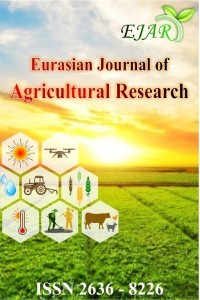NPK Contents of Vermicast as Influenced by Varying Substrates
NPK Contents of Vermicast as Influenced by Varying Substrates
Vermicomposting has been practiced for many years by several researchers for its positive outcomes toward sustainable agriculture. This study was conducted to assess the N, P, K content of vermicast as influenced by different substrates. Approximately, four (4) samples in each substrate as initial sample and vermicast as final sample were collected in the study. Varying substrates include the use of cow manure, mudpress, banana peelings, some leguminous plants namely kudzu and kakawate. Substrates and vermicasts among all treatments range from slightly acidic to slightly alkaline condition. There were considerably decreased in terms of pH, total N, K from its initial sample (substrate) to its final sample (vermicast) except for total P. Thus, this could be attributed to the nature and properties of varying substrates fed to the earthworms.
Keywords:
Vermicast, organic substrates total N, P, K,
___
- Basker, A., A. N. Macgregor, J. H. Kirkman. 1992. Influence of soil ingestion by earthworms on the availability of potassium in soil: An incubation experiment. Department of Soil Science, Massey University, Palmerston North, New Zealand. 14: 300-303.
- Budelman A. 1989. Nutrient composition of the leaf biomass of three selected woody leguminous species. Agroforestry Systems 8:39-51.
- Chen, J. H. and Lena. 2001. Effect of substrate concentration on bioleaching of metal-contaminated sediment, J. Haard. Mat. 82, 77-89 pp.
- Dodd, J., I. Arias, I. Koomen, and D. Hayman. 1990. The management of populations of vesicular-arbuscular mycorrhizal fungi in acid-infertile soils of a savanna ecosystem. Plant Soil 122: 229-240.
- Edward, C. A., Lofty, J. R., 1972. Biology of Earthworms. Chapman and Hall, London.
- Entre Pinoys. 2010. Retrieved on September 29, 2010 from http://www.mixph.com/2006/12/vermiculture-the-management-of-worms.html. Food and Agriculture Organization of the United Nations (FAO). 2006. Guidelines for soil description (4th ed.). Rome, Italy.
- Ghosh, M., G. N. Chattopadhyay, K. Baral. 1998. Transformation of phosphorus during vermicomposting. Bioresource Technology69 (1999) 149-154.
- Greipsson, S., and A. Ditommaso. 2006. Invasive non-native plants alter the occurrence of arbuscular mycorrhizal fungi and benefit from this association. Ecol. Restor. 24: 236-241.
- Hand, P., Hayes, W. A., Frankland, J. C., Satchell, J. E. 1988. Vermicomposting of cow slurry. Pedobiologia. 31. 199-209.
- Lazcano C., M. Gómez-Brandón, J. Domínguez. 2008. Comparison of the effectiveness of composting and vermicomposting for the biological stabilization of cattle manure. Chemosphere 72 (2008) 1013–1019.
- Lee, K. E., 1992. Some trends opportunities earthworm research or Darwin children. The future of our discipline. Soil Biol. Biochem., 24: 1765-1771.
- Mansell, G. P., Syers, J.K., Gregg, P. E. H., 1981. Plant availability of phosphorus in dead herbage ingested by surface-casting earthworms. Soil Biol. Biochem. 13, 163–167.
- Mencide, B. S. 2011. Effects of guano and inorganic fertilizer on the growth and yield of lowland rice. Undergrad. Thesis, VSU, Baybay, Leyte. 40 pp.
- Nelson, D. W. and L. E. Sommers. 1982. Total carbon, organic, and organic matter. Pp 539-579. In: A.L. Page, R.H. Miller and D.R Reeney (eds). Methods of soil analsysis Part2: Chemical and microbiological properties. American society of Agronomy, Inc., Madison, Wisconsin USA.
- PCARR, 1980. Standard methods of analysis for soil, plant tissue, water and fertilizer. Farm and systems res. Div. Philippine Council for Agriculture and Resources Research, Los. Banos. 164 pp.
- Ranin, L.A. 2015. Physical and chemical characteristics of vermicompost as affected by different feed formulations. Thesis, VSU, Philippines.
- Rogayan, D. Jr. 2010. Vermiculture and vermicompost.
- SatchelL, J. E., Martin, K., 1984. Phosphate activity in earthworm faeces. Soil Biol. Biochem. 16, 191–1
- Vasanthi D., Kumaraswamy K. 1999. Efficacy of Vermicompost to Improve Soil Fertility and Rice Yield
- ISSN: 2636-8226
- Yayın Aralığı: Yılda 2 Sayı
- Başlangıç: 2017
- Yayıncı: Muhammed Cüneyt BAĞDATLI
Sayıdaki Diğer Makaleler
Detecting the Chemical Changes of Sugar Beet by Using Remote Sensing Technology
NPK Contents of Vermicast as Influenced by Varying Substrates
Christian Ulysses CAGASAN, Malvin DATAN, Warren Kim SİAROT
Investigation of the Lagged Effects of Livestock Supports on the Animal Production Value in Turkey
significance of cryopreservation biotechnology for protection of aquatic species
Advantages of Using the Biofertilizers in Ukrainian Agroecosystems
